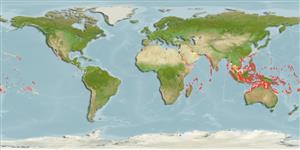>
Anguilliformes (Eels and morays) >
Congridae (Conger and garden eels) > Heterocongrinae
Etymology: Heteroconger: Greek, heteros = other + Latin, conger = conger (Ref. 45335).
Eponymy: Hans Hass (1919–2013) was an Austrian biologist, underwater cinematographer and scuba-diving pioneer. [...] (Ref. 128868), visit book page.
Environment: milieu / climate zone / distribuzione batimetrica / distribution range
Ecologia
marino associati a barriera corallina; non migratori; distribuzione batimetrica 1 - 50 m (Ref. 90102). Tropical; 25°C - 29°C (Ref. 130583); 30°N - 23°S
Indo-Pacific: Red Sea and East Africa to the Society Islands, north to the Ryukyu and the Ogasawara islands, south to northwestern Australia and New Caledonia; throughout Micronesia (Ref. 1602).
Size / Peso / Age
Maturità: Lm ? range ? - ? cm
Max length : 45.0 cm TL maschio/sesso non determinato; (Ref. 130583)
Spine dorsali (totale) : 0; Raggi dorsali molli (totale) : 449 - 540; Spine anali: 0; Raggi anali molli: 273 - 334; Vertebre: 163 - 177. Variable but usually two large black spots are obvious; body diameter to about 14 mm (Ref. 48635). Anterior nostrils included in continuous free labial flange. Pectoral fins minute. Total vertebrae 163-177, anal origin below vertebra 59-66.
Body shape (shape guide): eel-like; Cross section: circular.
Often found on sandy slopes below 15 m; withdraws into its burrow when approached. Usually in colonies containing up to several hundred individuals. Adults feed on zooplankton (Ref. 89972). Minimum depth reported taken from Ref. 86942.
Life cycle and mating behavior
Maturità | Riproduzione | Deposizione | Uova | Fecundity | Larve
Randall, J.E., G.R. Allen and R.C. Steene, 1990. Fishes of the Great Barrier Reef and Coral Sea. University of Hawaii Press, Honolulu, Hawaii. 506 p. (Ref. 2334)
IUCN Red List Status (Ref. 130435: Version 2025-1)
Threat to humans
Harmless
Human uses
Pesca: commerciale; Acquario: Commerciale
Strumenti
Special reports
Download XML
Fonti Internet
Estimates based on models
Preferred temperature (Fonte Biblio.
123201): 25.4 - 29, mean 28 °C (based on 654 cells).
Phylogenetic diversity index (Fonte Biblio.
82804): PD
50 = 0.5000 [Uniqueness, from 0.5 = low to 2.0 = high].
Bayesian length-weight: a=0.00102 (0.00046 - 0.00225), b=3.06 (2.88 - 3.24), in cm total length, based on all LWR estimates for this body shape (Ref.
93245).
Trophic level (Fonte Biblio.
69278): 3.4 ±0.4 se; based on size and trophs of closest relatives
Resilienza (Fonte Biblio.
120179): Medio, tempo minimo di raddoppiamento della popolazione 1.4 - 4.4 anni (Preliminary K or Fecundity.).
Fishing Vulnerability (Ref.
59153): Low to moderate vulnerability (35 of 100).
🛈
Nutrients (Ref.
124155): Calcium = 60.3 [33.5, 97.1] mg/100g; Iron = 0.698 [0.420, 1.147] mg/100g; Protein = 18.2 [15.2, 21.2] %; Omega3 = 0.111 [0.051, 0.316] g/100g; Selenium = 38.9 [21.1, 80.8] μg/100g; VitaminA = 97.6 [27.9, 327.8] μg/100g; Zinc = 1.2 [0.8, 1.7] mg/100g (wet weight);
